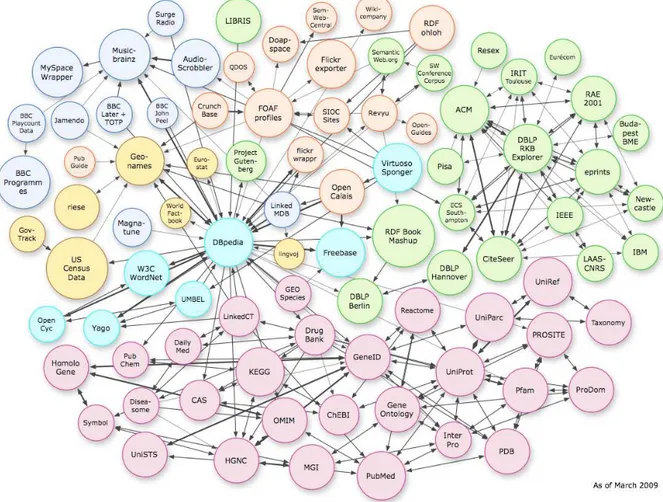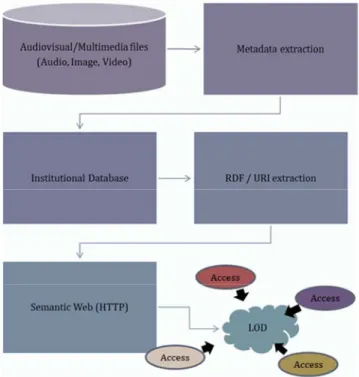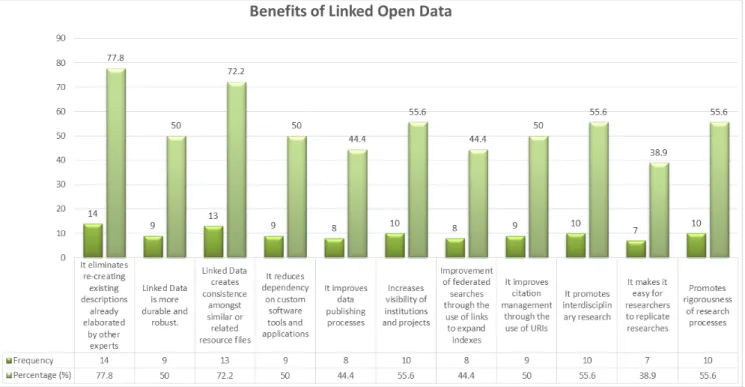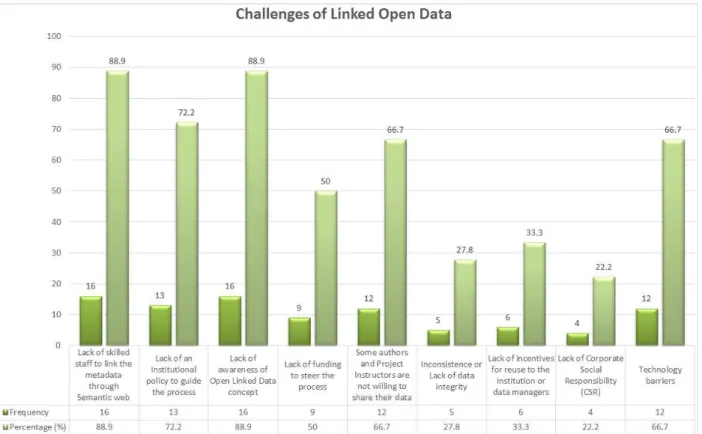http://www.sciencepublishinggroup.com/j/ajdmkd doi: 10.11648/j.ajdmkd.20170204.14
The Horizon of Information Sharing at Makerere University:
Multimedia, Audiovisual and the Linked Open Data
Onan Mulumba
1, Alison Annet Kinengyere
2, Winny Nekesa Akullo
31
College of Agricultural and Environmental Sciences Library, Makerere University, Kampala, Uganda 2
Albert Cook Medical Library, Makerere University, Kampala, Uganda 3
Public Procurement and Disposal of Public Assets Authority, Kampala, Uganda
Email address:
omulumba@gmail.com (O. Mulumba), omulumba@mulib.mak.ac.ug (O. Mulumba), alison.kine@gmail.com (A. A. Kinengyere), alisonk@chs.mak.ac.ug (A. A. Kinengyere), nekesawinny@gmail.com (W. N. Akullo)
To cite this article:
Onan Mulumba, Alison Annet Kinengyere, Winny Nekesa Akullo. The Horizon of Information Sharing at Makerere University: Multimedia, Audiovisual and the Linked Open Data. American Journal of Data Mining and Knowledge Discovery. Vol. 2, No. 4, 2017, pp. 114-120. doi: 10.11648/j.ajdmkd.20170204.14
Received: October 19, 2017; Accepted: November 3, 2017; Published: December 25, 2017
Abstract:
Makerere University has, in the recent past, climbed up the academic and research ranks, globally, and this has been supported by excellent information services, covering all available information resource formats and targeting users in the university community with varying information needs and information seeking behaviour. The metadata of such useful information resources is Machine-Readable. The major objective of this paper was to explore the level of data sharing at Makerere university library, focusing on audiovisual and multimedia collection. A semi-structured questionnaire (online and print) was administered to Library staff at Makerere University. The data were qualitatively and quantitatively analysed using simple percentages and recorded in tables and graphs. Of the 22 target respondents, a response rate of 81.8% (18) was realized. The results of the paper revealed that the majority of the librarians were not aware of the functionality of the LOD concept and the semantic web. Majority (88.9%) of the librarians were involved in data processing and entry for the general library collection, 18.8% of them are involved in data processing and entry for audiovisual and multimedia collection. It was further revealed that the data at Makerere university library is not linked to open data cloud and therefore not discoverable through the semantic web. The most prominent benefit of LOD cited by librarians was the opportunity to eliminate or reduce recreating existing descriptors already elaborated by other experts. The major challenges to linking data to open data cloud at Makerere university library were lack of skilled staff and lack of awareness about the concept of LOD.Keywords:
Linked Open Data, Audiovisual, Multimedia, Open Science1. Introduction
Makerere University is Uganda’s premier institution of higher learning, and enrolls about 40,000 students [1]. Makerere is one of the largest universities in East and Central Africa. The university is also among the oldest and most prestigious universities in Africa [2]. It was established in 1922 as a technical school and became the university of East Africa in 1963. It migrated to a collegiate system in 2011 and currently has 10 colleges
At the centre of Makerere University is the Library system comprising of the Main Library, which is situated at Makerere University Main Campus. It was constructed in 1959 with a total area of 4,000 square metres and was
extended in 1962, 1972 and 2006. The extensions increased the area to 12,000 square metres with a seating capacity of over 2,800. The Main Library currently has eight sections namely: Technical Services, Periodicals/Serials, Reference and Circulation (including the Law collection and IDA/Basic textbook Reserve collection), Africana Section, Information and Communication Technology (ICT), Microfilming and Digitization, Book Bank and Bindery.
historical value. The Digitization section is mandated to scan and electronically archive the rare materials, for preservation and easy access by scholars and researchers. The audiovisual information resources in Makerere University Library are processed and shelved or archived for easy access by patrons who wish to use them. During processing metadata for these resources is generated and stored on institutional servers. The Library software Virtua, a product of VTLS is used during cataloguing processes to create the metadata. Cataloguing is generally for the entire library collection to make the metadata directly accessible through MaKULA, which is the Online Public Access Catalogue for Makerere University. The institutional generated research, and other materials are provided through Makerere Institutional Repository (at MakIR.mak.ac.ug) to the public domain. The institutional repository provides access to the Dublin Core metadata of the resources, including datasets, image files, and music files among others.
This study focuses on how the current and prospect information and data sharing practices of the Multimedia and Audiovisual collection at Makerere University. In their study about semantic tagging with Linked Open Data, Cuzzola et al. (2013) looked at ‘Denote’; a semantic tagging platform based on Linked Open Data. While comparing it with the other annotators like; TagME, DBPedia Spotlight, and Alchemy, they [3] cited three advantages of Denote; its attempt to assign context to the annotations by its lexicon, its
attempt to annotate through statistical analysis of similar concepts whose <predicate>:<object> are of the same data type, and having an extensive list of topic categories, made available through DBPedia’s <dcterms: subject> predicate, which it assigns to its annotations.
1.1. Linked Open Data (LOD)
By definition ‘linked data is a data publishing technique that uses common web technologies to connect related data and make them accessible on the web’ [4]. LOD which is a web of data has gained momentum in the recent years and many data sets have been published following the LOD principles [5]. They further highlight four principles governed by LOD:
1. that all items in a dataset should be identified using URIs;
2. all URIs should be dereferenceable: using HTTP URIs, which allows looking up an item identified through an URI;
3. when looking up an URI, it leads to more data (typically represented in RDF);
4. links to URIs in other datasets should be included in order to enable the discovery of more data.
The principles create patterns that make data sets linking and widely discoverable through the Semantic Web (World Wide Web) to the linked open databases, as shown in figure 1.
Hausenblas and Karnstedt (2010) note that linked data is largely about publishing structured data in RDF using HTTP URIs, hence lowering the entry barrier for data providers and data consumers, in contrast to the fullfledged Semantic Web vision. The Semantic Web functions when computers have access to structured collections of information and sets of inference rules which they use to conduct automated reasoning [7]. Furthermore the Semantic Web is centered on Resource Description Framework (RDF) which is a set of specifications published by the World Wide Web Consortium (W3C) maintaining standards for the web, and RDF uses an abstract data model to store metadata in a variety of interchangeable file formats.
In principle the processes through which the multimedia and audiovisual are processed and metadata made accessible in an open linked cloud starts with Identifying the files, extract metadata, storage of the data in an institutional database (accessible locally by the institutional), extraction of the Resource Description Formation files, with links through the semantic web and finally linking to the linked open databases like DBPedia. From this point, users and institutions from all over the world can directly access the metadata, without necessarily going through the institution.
Figure 2. Linking metadata of institutional multimedia and audiovisual files to LOD multimedia and audiovisual.
Multimedia is define by Merriam-Webster online dictionary as a technique, combining sound, video, and text, for expressing ideas in communication, entertainment, or art, in which several media are employed; also having a software, using or facilitating such a technique. It also defines audiovisual resources as resources designed to aid learning or teaching by making use of both hearing and
sight. The terms multimedia and audiovisual are interlinked and therefore multimedia users require some understanding of audiovisuals [9]. Archivists who deal with audiovisual records face a big challenge when compared with their counterparts dealing with traditional paper records. The rapidly changing technology threatens to render the media file formats containing audiovisual records obsolete and inaccessible [10]. However, the metadata of the audiovisual records remain accessible but may be of a less significant value.
1.2. Problem Statement
A lot of research is conducted in the various sections of Makerere University, as one of the core activities from which it attains pride and excellence. Similarly more research output is realized from the different institutions and research centers around the country. Makerere University Library being the National Legal Deposit center houses a collection of information materials from authors and institutions around the country. Data sets from the different research projects may be physically available and relevant but not accessible via the web, to the wider community that may need to use it, before it becomes obsolete. It is also relevant that data sets are made readily accessible to avoid wastage of money in duplication of research. While the information materials are catalogued and metadata made available through the Online Public Access Catalogue (OPAC), it was likely that the data is not widely accessible through a linked web platform. Therefore, it was relevant to conduct this study to establish the status quo, and to conduct a SWOT analysis of sharing data of multimedia and audio resources in the cloud, using the Linked Open Data.
1.3. Objectives of the Study
The major objective of this paper was to explore the possibilities and mechanisms through which metadata of Makerere University library audiovisual and multimedia collection can be made more available to the communities, both physically at the university and in the diaspora, through Linked Open Data support tools. Specifically this paper focused on the following objectives:
1. determining the status and possibility of Makerere university Library in using the Semantic Web concepts in providing access to multimedia and audiovisual data through Linked Open Data;
2. conducting a SWOT analysis of the current data sharing practices and how it is likely to perform in the future.
1.4. Justification
the projects, much of the data acquired is shelved and not shared. It is prudent that data is openly linked to external databases and shared so that other institutions, organizations and individuations can utilize it to support related or similar activities.
2. Methodology
A questionnaire (online and print) was administered to librarians at Makerere University to establish their knowledge of data sharing and the concept of Linked Open Data. The online questionnaire was sent to individual email addresses. This was helpful in reaching out to respondents who were hard to find, it was time-saving, as well as cost effective [11].
2.1. Population
The study population comprised 18 Librarians at Makerere University, performing different information management tasks.
2.2. Analysis and Discussion
Data was gathered basing individual responses from the Librarians at Makerere University. Of the 22 copies of the questionnaire emailed and hand-delivered to individual Librarians, only 18 (81.8%) of the responses were received.
Demographic Data
The demographic distribution of the respondents was analyzed using simple percentages and presented in form of tables. Table 1. Below shows the gender distribution of the respondents.
Table 1. Gender distribution of respondents.
Gender Frequency Percentage (%)
Male 5 27.8
Female 13 72.2
Other 0 0
Total 18 100
The results from table 1 show that the majority of the respondents were females (72.2%) whereas the males were only 5 (27.8%). This is possibly caused by the perceived dominance of the females in the LIS profession. A third gender option (other) was included in the survey to cater for the cultural-historical categories, rather than the traditional sexual dimorphism of Male-Female biological formation [12]. However, this provision received no response.
Table 2. Age distribution of the respondents.
Age classes (years) Frequency Percentage (%)
21 - 30 0 0
31 - 40 14 77.8
41 - 50 3 16.7
Above 50 1 5.6
Total 18 100
It is observed from table 2 that the majority of the respondents (77.8%) were aged between 30 and 40 years.
Three (16.7%) of the respondents were aged between 40 and 50 years. Only one (5.6%) of the respondents was above 50 years of age. This shows that Makerere University generally has a youthful team of librarians and that this team has the
capacity to accommodate and embrace emergent
technologies.
The study shows that of the 18 respondents 13 (72.2%) have Master’s degrees whereas the remaining 5 (27.8%) respondents have Bachelor’s degrees. Therefore, the majority of the Librarians at Makerere University have sufficient skills to facilitate implementation of a number of applications to enhance information sharing.
Respondents’ positions / ranks in the University
The study sought to establish the positions of the respondents to the survey, in the University Library. The Library has different categories of staff ranging from support staff (Library Assistants) to professional staff (Librarians II, I and Senior). The academic levels proceed to the rank of a professor.
Table 3. Respondents’ positions / ranks in the University Library.
Position/rank Frequency Percentage (%)
Library Assistant 2 11.1
Librarian II 8 44.4
Librarian I 7 38.9
Senior Librarian 0 0
Systems Administrator 1 5.6
Total 18 100
It was observed from the study that 8 (44.4%) of the respondents were Librarians II, well as 7 (38.9%) were Librarians I. The other respondents were Library assistants and the systems administrator. The Library Assistants who participated in the survey are those that are qualified librarians but not yet promoted to the professional ranks. It is expected that the Systems Administrator is aware of the technology structure of the library and that such input would be very vital in establishing the data sharing structure in Makerere University. The high responses for Librarians II and I indicates that the library professional team is dominated by Librarians II and I.
Of the 18 respondents, it emerged that 16 (88.9%) are involved in the cataloguing and data entry of the general library collection, however, of these, only 3 (18.8%) are involved with data processing and entry for the multimedia collection.
3. Results
This sections presents findings of the study at Makerere University, reporting the practices of management, use and sharing of information for audiovisual and multimedia resources.
3.1. Awareness and Use of Linked Open Data (LOD) Applications
were not aware, whereas the rest (33.3%) were aware. When asked if they used LOD applications such as Library of Congress Subject Headings (LCSH) 9 (50%) of the respondents indicated that they use LOD. This discrepancy shows that most Librarians are using LOD applications without awareness. Amongst the LOD tools used, LCSH was observed to be used most by 9 (50%) of respondents, Wikipedia and Digital Object Identifier (DOI) by 6 (33.3%) each as well as Open Library by one respondent. The limited awareness of LOD applications may also imply that the respondents are using much more applications than reported in this survey.
3.2. Metadata Sharing Via Semantic Web
A question was asked to find out if the Librarians knew whether the data they process is linked to the external
environment through the Semantic Web. The results of the study show that 10 (55.6%) responded to the question but the majority (80%) didn’t know, whereas one of the remaining 2 reported that the data is not linked while the other reported that the data is linked. From this study it is clear that most Librarians don’t understand the concept of Linked Open Data and each one of them has a different perspective of the concept. The response from the Systems Administrator also showed no idea about data being linked to open data platforms.
3.3. Benefits of Linking and Sharing Data to Open Data Cloud through the Semantic Web
The survey sought to establish what the respondents perceived as the benefits of sharing data to the open data cloud. The results of the study are presented as classified in Figure 3 below.
Figure 3. Benefits of Linked Open Data cloud.
From the figure above it is observed that the most perceived benefit of LOD is the elimination of re-creating existing descriptors already elaborated by other experts. This benefit was revealed 14 (77.8%) of the respondents. Other benefits include; creation of consistence amongst similar or related resource files (72.2%), increasing visibility of institutions and projects (55.6%), promoting interdisciplinary research (55.6%), promoting rigorousness of research processes (55.6%), Linked Data is more durable and robust (50%), reduces dependency on custom software tools and applications (50%), improves citation management through the use of URIs (50%), improves data publishing processes (44.4%), improvement of federated
searches through the use of links to expand indexes (44.4%), and enabling of easy replication of research by researchers (38.9%).
3.4. Challenges of Linking Data to Open Data Cloud at Makerere University
Figure 4. Challenges of Linked Open Data cloud.
The results of the study reveals that the most prominent challenges to Linked Open Data are; lack of skilled staff to link the data to Open Data cloud, and lack of awareness of the concept, with a response rate of 88.9%. Other major challenges include; lack of an institutional policy to guide and facilitate the data linking process, some authors and Project Instructors not willing to share their data, and the technology barriers. All these challenges are likely to significantly affect the linking of data of AV and Multimedia resources to the Open Data cloud. Other challenges include; lack of funding to steer the data linking process, inconsistence or Lack of data integrity, lack of incentives for reuse to the institution or data managers, and Lack of Corporate Social Responsibility (CSR). All the major challenges manifest as weaknesses to the institutional because the institution has total control over them. However, one the other hand other challenges are merely threats to the data linking process because the institution has no control over them.
4. Conclusion
In this study, the majority (72.2%) of the respondents were females, and mainly aged between 31 and 40 years. Most of the respondents were professional librarians at the rank of Librarian I and II, and among the respondents was a Systems Administrator. Whereas the majority of the librarians were involved in data processing and entry of the general collection, only three were involved with Multimedia and Audiovisual collection data processing.
Linked Open Data is very vital in steering data sharing
through the Semantic Web, however it was observed from the study that Most Librarians at Makerere University were not aware of the concept. It was also established that the Metadata of the collection was not linked to Open Data cloud because the majority of the Librarians and the Systems Administrator did not have any idea of the application through which the data is linked. It was observed that most Librarians appreciate the benefit of LOD, especially in elimination of re-creating existing descriptors already elaborated by other experts. However, a number of challenges were quoted and most prominently were; lack of skilled staff to link the data, and lack of awareness for the Linked Open Data cloud concept. It was noted that the major challenges cited are largely due to internal structures, over which the institution has total control. It is, thus, recommended that a lot of effort should be put in creating awareness and training staff to be able to link the data to Open Data cloud, while handling other internal restrictions like policy formulation.
References
[1] A. Namaganda and P. Sekikome, “Users ’ Perceptions of Makerere University Library Services,” Qualitative and Quantitative Methods in Libraries (QQML), vol. 4, pp. 403– 410, 2013.
[3] J. Cuzzola, Z. Jeremic, E. Bagheri, D. Gasevic, J. Jovanovic, and R. Bashash, “Semantic tagging with linked open data,”
CEUR Workshop Proceedings, vol. 1054, pp. 52–53, 2013. [4] B. Haslhofer and A. Isaac, “data.europeana.eu: The Europeana
Linked Open Data Pilot,” International Conference on Dublin Core and Metadata Applications, no. iii, pp. 94–104, 2011. [5] M. Hausenblas and M. Karnstedt, “Understanding linked open
data as a web-scale database,” 2nd International Conference on Advances in Databases, Knowledge, and Data Applications, DBKDA 2010, pp. 56–61, 2010.
[6] R. Cyganiak and A. Jentzsch, “The Linking Open Data cloud diagram,” 2009. [Online]. Available: http://lod-cloud.net/. [Accessed: 14-May-2016].
[7] M. Willer and G. Dunsire, “2 - Semantic web and linked open data,” Bibliographic Information Organization in the Semantic Web, pp. 85–136, 2013.
[8] “Merriam-Webster,” Dictionary. [Online]. Available: www.merriam-webster.com/dictionary. [Accessed: 17-May-2016].
[9] J. A. G. M. van Dijk and A. J. A. M. van Deursen, Digital Skills: unlocking the information society. New York, USA: Palgrave macmillan, 2014.
[10] S. Greene, “Chasing Technology: The Challenge of Preserving Audiovisual Records,” Prologue, vol. 39, no. 2, 2007. [11] K. B. Wright, “Researching Internet-based populations:
Advantages and disadvantages of online survey research, online questionnaire authoring software packages, and web survey services,” Journal of Computer-Mediated Communication, vol. 10, no. 3, p. 0, 2005.




